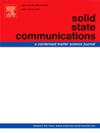Theoretical investigations on the structural, elastic, electronic, and magnetic properties of cubic SrXO3 (X = V, Ru) perovskites
IF 2.1
4区 物理与天体物理
Q3 PHYSICS, CONDENSED MATTER
引用次数: 0
Abstract
In this paper, we studied the structural, elastic, magnetic, and electronic characteristics of the compounds SrVO3 and SrRuO3 by employing the Full-Potential Linearized Augmented Plane wave (FP-LAPW) method, as implemented in the Wien2k code. The properties of SrXO3 where X = V and Ru were investigated utilizing different theoretical estimates. We examined the relationship between total energy and volume, applying for both ferromagnetic and nonmagnetic states by the Wu-Cohen Generalized Gradient Approximation. We first calculated the lattice parameters of SrXO3, and after that, we determined the two- and three-dimensional compressive modulus, modulus of Young, ratio of Poisson, and modulus of shear. Additionally, both the WC-GGA and mBJ-GGA schemes estimates were employed to analyze the band structure, the total and partial density of SrXO3 within the Brillouin zone. In addition the magnetic properties was investigated by calculating the magnetic total (Mtot) and partial (MSr, M(V, Ru) and MO) moments. There is concordance between our results and with previous works.
立方SrXO3 (X = V, Ru)钙钛矿结构、弹性、电子和磁性能的理论研究
本文采用Wien2k代码实现的全势线性化增宽平面波(FP-LAPW)方法研究了化合物SrVO3和SrRuO3的结构、弹性、磁性和电子特性。利用不同的理论估计研究了X = V和Ru时SrXO3的性质。我们用Wu-Cohen广义梯度近似检验了总能量和体积之间的关系,并应用于铁磁和非磁态。我们首先计算了SrXO3的晶格参数,然后确定了二维和三维压缩模量、杨氏模量、泊松比和剪切模量。此外,采用WC-GGA和mBJ-GGA方案估计SrXO3在Brillouin区内的能带结构、总密度和偏密度。此外,通过计算磁性总矩(Mtot)和偏矩(MSr, M(V, Ru)和MO)来研究其磁性能。我们的结果和以前的工作是一致的。
本文章由计算机程序翻译,如有差异,请以英文原文为准。
求助全文
约1分钟内获得全文
求助全文
来源期刊

Solid State Communications
物理-物理:凝聚态物理
CiteScore
3.40
自引率
4.80%
发文量
287
审稿时长
51 days
期刊介绍:
Solid State Communications is an international medium for the publication of short communications and original research articles on significant developments in condensed matter science, giving scientists immediate access to important, recently completed work. The journal publishes original experimental and theoretical research on the physical and chemical properties of solids and other condensed systems and also on their preparation. The submission of manuscripts reporting research on the basic physics of materials science and devices, as well as of state-of-the-art microstructures and nanostructures, is encouraged.
A coherent quantitative treatment emphasizing new physics is expected rather than a simple accumulation of experimental data. Consistent with these aims, the short communications should be kept concise and short, usually not longer than six printed pages. The number of figures and tables should also be kept to a minimum. Solid State Communications now also welcomes original research articles without length restrictions.
The Fast-Track section of Solid State Communications is the venue for very rapid publication of short communications on significant developments in condensed matter science. The goal is to offer the broad condensed matter community quick and immediate access to publish recently completed papers in research areas that are rapidly evolving and in which there are developments with great potential impact.
 求助内容:
求助内容: 应助结果提醒方式:
应助结果提醒方式:


